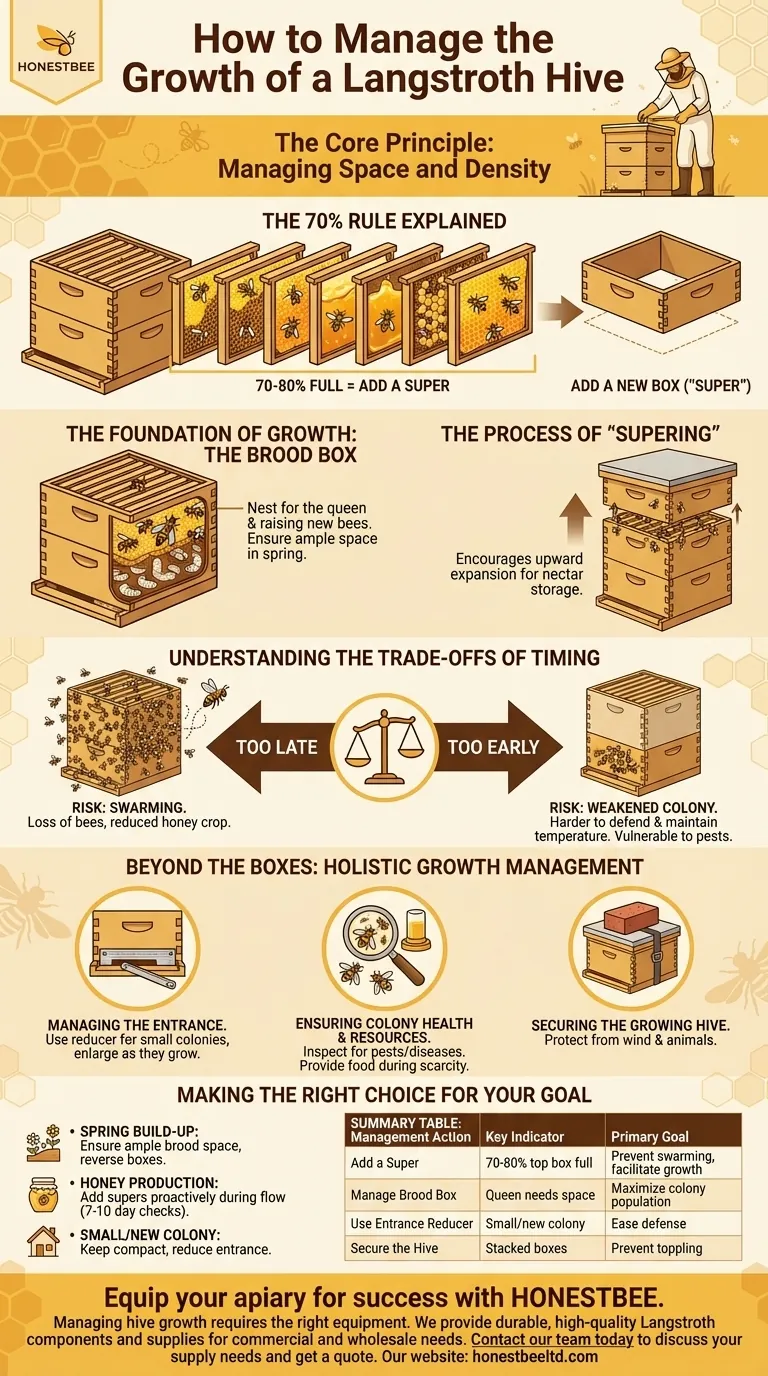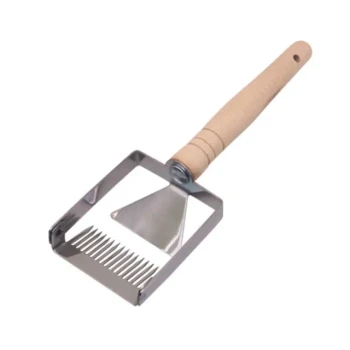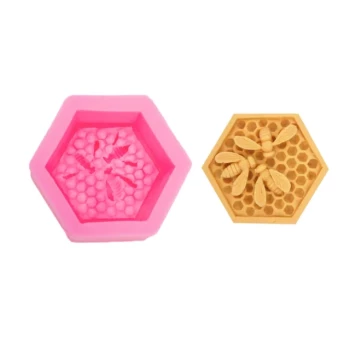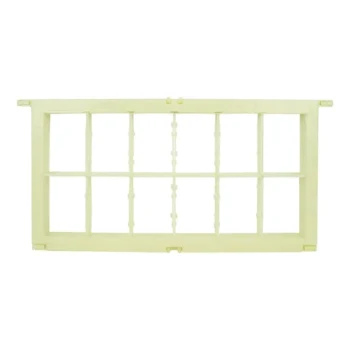To manage the growth of a Langstroth hive, a beekeeper adds a new box, or "super," on top of the existing ones. The key indicator for this expansion is when the bees have utilized approximately 70% of the frames in their current topmost box, either by drawing out comb, storing nectar, or raising brood.
The beekeeper's core task is not to force growth, but to strategically manage space. Providing just enough room at the right time prevents the colony from swarming while ensuring the hive isn't overextended and vulnerable.

The Core Principle: Managing Space and Density
A healthy honeybee colony has a powerful, instinctual drive to expand its population and store resources. The beekeeper's role is to facilitate this natural cycle by managing the physical space of the hive.
The 70% Rule Explained
The most common guideline is to add a new box when the existing top box is about 70-80% full. This means that on 7 or 8 out of 10 frames, bees are actively building comb, storing honey, or raising young bees (brood).
This metric provides the colony with room to expand before it feels congested, which is a primary trigger for swarming.
The Foundation of Growth: The Brood Box
All hive growth originates in the brood boxes at the bottom of the hive. This is the nest where the queen lays her eggs and the colony raises the next generation of bees.
Especially in the spring, the beekeeper must ensure the brood boxes are in good condition and provide ample space for the queen to maximize her egg-laying rate. A "brood-bound" queen with no room to lay will halt the colony's growth.
The Process of "Supering"
Adding a new box is known as "supering." The new super is typically placed on top of the highest box that the bees currently occupy.
This encourages the bees' natural tendency to move upwards as they gather nectar and expand their storage.
Understanding the Trade-offs of Timing
Managing hive growth is a balancing act. The timing of when you add space is just as important as the act itself.
The Risk of Adding Space Too Late: Swarming
If a colony runs out of space, it will likely swarm. The bees will raise a new queen, and the old queen will leave with roughly half the colony's population to find a new home.
For the beekeeper, a swarm represents a significant loss of bees and a drastic reduction in the hive's potential honey crop. Proactive space management is the primary method for swarm prevention.
The Risk of Adding Space Too Early: A Weakened Colony
Giving a colony too much space before it's ready can be detrimental. The bees must work to patrol, defend, and maintain the temperature and humidity of the entire interior volume.
An excessive amount of empty space can overtax a smaller colony, making it harder for them to stay warm and leaving them vulnerable to pests like wax moths or small hive beetles.
Beyond the Boxes: Holistic Growth Management
Effective management goes beyond simply adding supers. It involves tending to the colony's overall security and health to support its population growth.
Managing the Entrance
The size of the hive entrance should correspond to the colony's population. Beekeepers use entrance reducers to shrink the opening for smaller or newer colonies.
A smaller entrance is easier to defend against robbing bees or predators. As the colony grows and needs more ventilation and flight traffic, the entrance can be enlarged.
Ensuring Colony Health and Resources
A colony cannot grow if it is sick or starving. A fundamental part of management is conducting regular inspections for pests and diseases like Varroa mites or foulbrood.
The beekeeper must also ensure the bees have an adequate food supply (honey or sugar syrup), especially during periods of nectar scarcity.
Securing the Growing Hive
As the hive grows taller with the addition of supers, it becomes more susceptible to being knocked over by wind or animals.
Securing the hive components together, often by placing a heavy rock or brick on the top cover or using a hive strap, is a simple but critical step in protecting the thriving colony.
Making the Right Choice for Your Goal
Your management strategy should adapt to the colony's strength and the time of year.
- If your primary focus is spring build-up: Ensure the brood nest has ample room for the queen to lay, reversing brood boxes if necessary to encourage upward expansion.
- If your primary focus is honey production: Add honey supers proactively during a strong nectar flow, checking every 7-10 days to stay ahead of the 70% rule.
- If your primary focus is supporting a small or new colony: Keep the hive compact with a reduced entrance, and only add a new box when they have thoroughly filled their current space.
Ultimately, successful hive management is about observing your colony's needs and providing the right amount of space at precisely the right time.
Summary Table:
| Management Action | Key Indicator | Primary Goal |
|---|---|---|
| Add a Super | 70-80% of frames in top box are occupied | Prevent swarming, facilitate growth |
| Manage Brood Box | Queen has ample laying space | Maximize colony population |
| Use Entrance Reducer | Small or new colony | Ease defense against pests/robbers |
| Secure the Hive | Multiple boxes are stacked | Prevent toppling from wind/animals |
Equip your apiary for success with HONESTBEE. Managing hive growth requires the right equipment at the right time. Whether you're a commercial apiary scaling up operations or a distributor supplying the beekeeping community, HONESTBEE provides the durable, high-quality Langstroth hive components and beekeeping supplies you need. From brood boxes and honey supers to essential tools, we support your growth goals through our wholesale-focused operations.
Contact our team today to discuss your supply needs and get a quote.
Visual Guide

Related Products
- Langstroth Bee Hives Bee Keeping Box for Beginners Beekeeping
- Long Langstroth Style Horizontal Top Bar Hive for Wholesale
- Wholesales Dadant Size Wooden Bee Hives for Beekeeping
- Professional Insulated Plastic Bee Hives
- Automatic Honey Flow Beehive 4 Frame Mini Hive for Beekeeping
People Also Ask
- How does the ease of access differ between 8-frame and 10-frame hives? Choose the Right Hive for Your Body
- Why are Langstroth hives recommended for beginners? Unmatched Support & Standardization
- How does the orientation of the hive sides benefit comb construction? Ensure Straight, Movable Combs for Easier Hive Management
- What are the different types of beehive boxes available? Choose the Right Hive for Your Apiary
- Should a beginner try a different type of hive? Start with a Langstroth for a solid foundation.



















